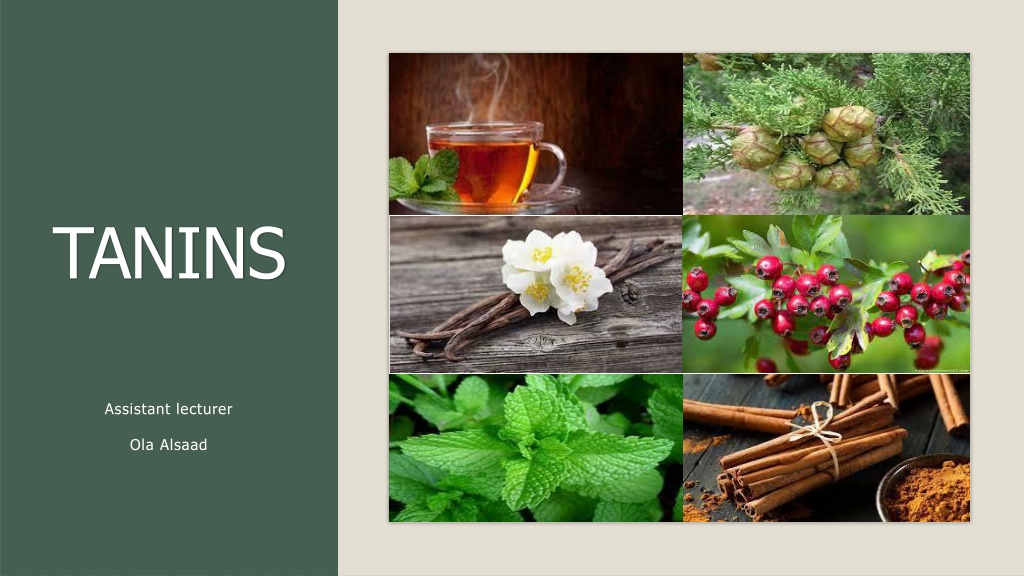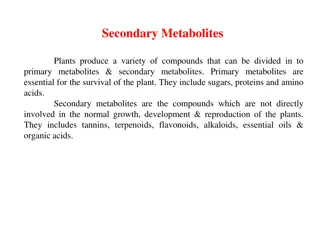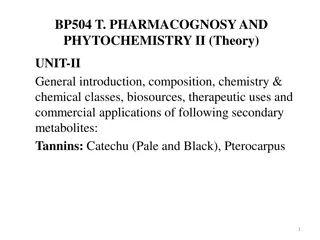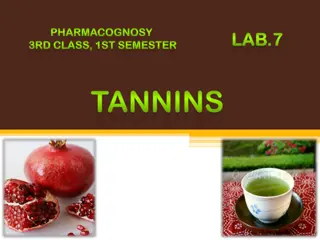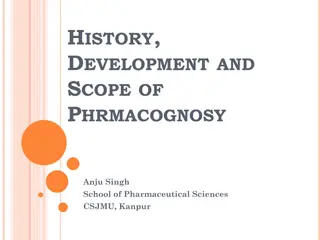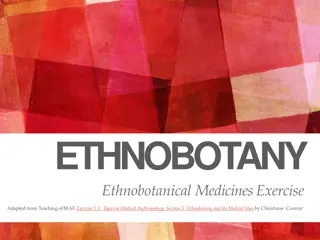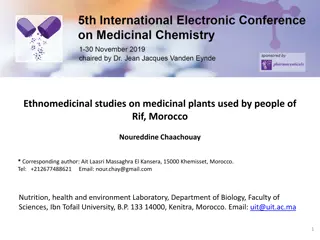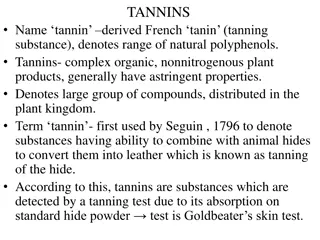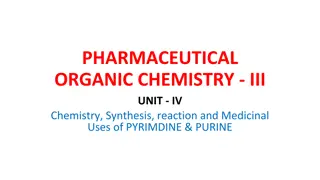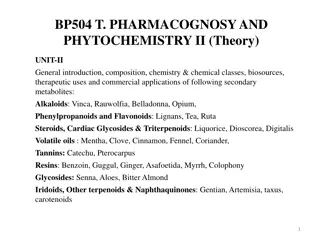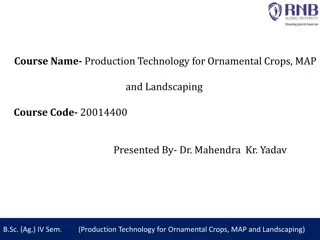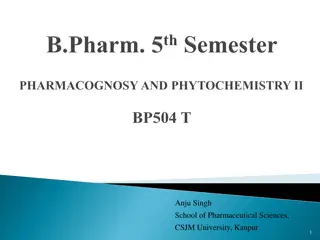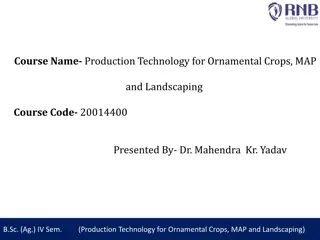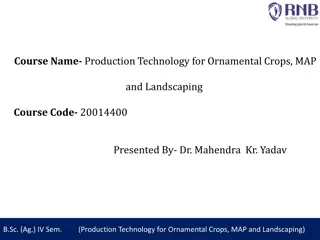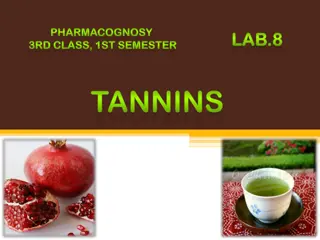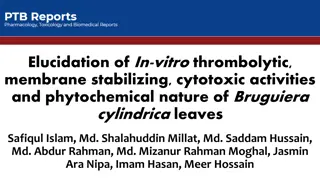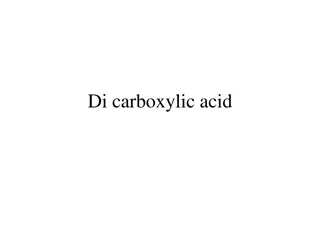Understanding Tannins: Properties, Classification, and Medicinal Uses
Tannins are secondary metabolite products with astringent properties, high molecular weight, and various solubility and taste characteristics. They can be classified into true tannins and pseudo-tannins based on the Goldbeater skin test, as well as hydrolysable and condensed tannins based on chemical structure. Tannins have medicinal properties such as acting as antioxidants, antibacterial agents, and aids in treating various conditions including burns, inflammation, ulcers, and throat infections.
Download Presentation

Please find below an Image/Link to download the presentation.
The content on the website is provided AS IS for your information and personal use only. It may not be sold, licensed, or shared on other websites without obtaining consent from the author. Download presentation by click this link. If you encounter any issues during the download, it is possible that the publisher has removed the file from their server.
E N D
Presentation Transcript
TANINS Assistant lecturer Ola Alsaad
TANNINS Secondary metabolite Products , naturally occurring complex organic compounds. Nitrogen-free polyphenols with high molecular weight. Precipitation of proteins and alkaloids. The property of tannins as an astringent is due to their ability to precipitate proteins and make them resistant for enzymatic attack.
Properties of tannins 1. Soluble in water (except for some highweight structures molecular), alcohols, dilute alkalis, and glycerin. 2. Insoluble in organic solvents, except acetone, slightly soluble in ethyl acetate. 3. It tastes bitter if the tannin content is high . 4. Color is yellowish white to brown . 5. High molecular weight ranges from 500 to >5,000 mw. 6. Form a non-crystallizable colloidal solution with water which leads to acidic reactions. 7. It has an astringent property and astringent taste in the mouth.
Classification of tannins Tannin compounds can be divided into two main groups based on the Goldbeater skin test : 1- True tannins : A group of tannins that show a positive Goldbeater skin test , high molecular weight(>500mw). 2- Pseudo-tannins :They are simple phenolic compounds with lower molecular weight(<500mw).It does not respond to the tanning reaction of the Goldbeater skin test. Examples: Cocoa , Coffee .
Classification of tannins Tannins can be divided into two main groups based on the chemical structure and hydrolytic reaction : 1- Hydrolysable tannins : They are ester of sugar and variable number of phenolic acid, they are hydrolysed by acids or enzyme , and produced Gallic acid and ellagic acid, soluble in water and their solution produces a blue color with ferric chloride. Examples: pomegranate , eucalyptus . 2- Condensed or Nonhydrolysable tannins : They are not readily hydrolysable in to simpler molecules , not contain sugar moity ,polymeric flvans , condensed tannins are also soluble in water and produce a green color with ferric chloride. Examples: Kola , Green tea .
Medicinal properties and uses 1. Astringent for burns and inflammation of mucous membranes. 2. Antioxidant, antibacterial, antifungal , anticancer . 3. Tannins are used to treat skin ulcers, hemorrhoids, frostbite, as well as inflammation of gums. 4. 5. 6. Stomach stimulant, blood thinner, diuretic. Sore throat, diarrhea, dysentery . Treatment for bee sting venom. 7. Control gastroenteritis, and in cases of heavy metal poisoning as an antidot. 8. In recent years, these compounds have proven their antiviral activity in treating viral diseases, including... AIDS.
Other uses of tannins 1. It is used in the leather tanning process. 2. Protect plants from herbivores. 3. Protect plants from microbial attacks. 4. Tannins are used as an adhesive in dyeing, ink making, silk. 5. Tannins are also used in photography, and as a coagulant in the rubber industry. 6. Detector in laboratories.
Tanins example Pomegranate Eucalyptus S.name : Punica granatum S.name:Eucalyptus camaldulenses Family: Punicaceae Family : Myrtaceae active part : Peels active part : Leaves and bark
The procedure Prepare plant extract : 1gm of plant in 200ml D.W (decoction method). 1- gelatin test : 1 ml of the extracts mixed with few drops of 1% gelatin solution ; the mixture gives white precipitate , (gelatin is protein). 2- Lead acetate tests: 1ml of extracts mixed with few drops 10% lead acetate ; the mixture gives white precipitate. 3-Ferric chloride (FeCl3) tests (Hydrolyzable tannins): 1ml of the extracts mixed with few drops of 5% Ferric chloride the mixture gives blue to black color.
THANK YOU THANK YOU
